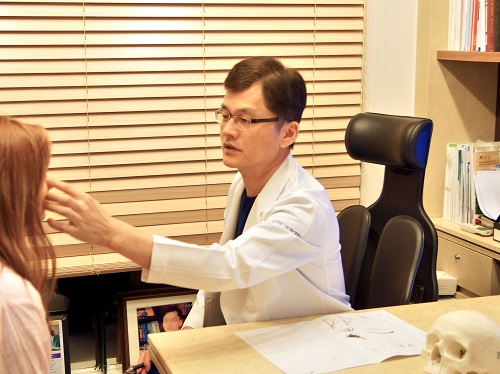
One part of the face has the highest occurrence of needing a revision among plastic surgery: the nose. Patient dissatisfaction plays the biggest role in this. In fact, many patients decide to retake surgery as to unlike their expectation of becoming prettier with a taller nose, they end up realizing how their new nose doesn’t harmonize with other parts of the face.
However, the nose has many functions such as breathing, smelling, and humidity maintenance—so there are many things to consider for plastic surgery. As a result, many plastic surgeons struggle with their patients' needs and requests. Fortunately, with the development of medical technology, medical devices that can view predicted images of before and after the surgery have come out in the world, allowing natural and safe nose shaping. Follow the head of JW Plastic Surgery in Seoman County and a doctor who doesn’t spare efforts for safe rhinoplasty, Suh Man-koon, as he unfolds more details.
- Nose is vital not only in terms of appearance, but also function.
The nose has many functions in our body, and among these, breathing is the most important. The nose also plays a pivotal role, such as maintaining both the sense of smell and humidity and filtering out dust from inhaled air. Therefore, the most important thing in rhinoplasty is to avoid disrupting the functions. Although many nose jobs are performed for aesthetic reasons, there are times when nose surgery is performed due to certain health conditions. Typically, the operation is carried out for a "deviated septum" in which a thin wall inside the nose is curved sideways.
-Why are there so many cases of nose revision?
"Dissatisfaction" is the most common cause according to my experience. Some people want to lengthen their noses no matter what. However, “naturalness” is very important as the nose and various parts such as the eyes, mouth, and ears exist on the face. This is a very difficult part for the medical staff. For instance, the rate of revision was high when the surgery was performed, leading to facial disharmony. A nose job should be carried out considering naturalness as it can be a shortcut to "plastic surgery addiction,” if it does not fit your face.
- Lately, personalized medical devices are cutting edge as it is very useful in the plastic surgical fields.
It's a very innovative technology. Our clinic is using “Innofit,” a device for creating customized nasal implants using 3D scanning. Innofit has virtual surgery software that accurately embodies what the patient wants and the medical team's surgical plan. It customizes considering the nasal bone and cartilage extracted from the patient in CT images and creates an implant based on 3D—taking into account the height, width, length, curved surface, and ratio of the patient's nose. This narrows the gap between the anatomical curved surface of the nose and the implants, minimizing the adhesion of the implant and concerns of shape defects.
- What type of implants are used for rhinoplasty?
The choice for implants is very important for nose surgery. There are many different types of implants such as Gore-Tex and silicon, and the latter is most used. Recently, many people worry about the side effects of implants, but silicon has been used for a long time, which has been proven to be safe. The biggest advantage of the material is that it is easy to handle and can be finely carved into the desired shape. However, if the skin is too thin, silicon may transfer or protrude. Therefore, it is important to identify the skin condition before surgery.
There is also non-implant surgery, using autogenous cartilage such as the nasal septum, autodermis, ear cartilage, and breast cartilage. The biggest advantage of autologous cartilage is that it has fewer side effects such as inflammation and skin necrosis and enables natural-look results. However, this type of nose job can't lengthen the middle of the forehead, so it's hard to make a high nose bridge. Also, caution is needed because the tip of the nose can droop or become uneven due to the weak bridge that raises the tip of the nose.
- As for any other surgery, care after surgery is significant.
The nose is a very vulnerable area to external shock. As a result, the shock can cause inflammation of inserted implants or bend the nose bridge. You have to be careful for about six months after the surgery when the surgical site heals and the nasal tissues stabilize. During this period, refrain from drinking and smoking, and avoid being in places with high temperatures such as saunas and spas. Also, take prescribed medication thoroughly to prevent inflammation. Nose revision is much more difficult than the first surgery. It is also recommended to undergo revision by a skilled doctor as it should be carried out half-year to a year after the first surgery. If you are concerned about "ghost surgery," check out whether the plastic surgeon is qualified or not through the Portal of Korean Plastic Surgeons website.


